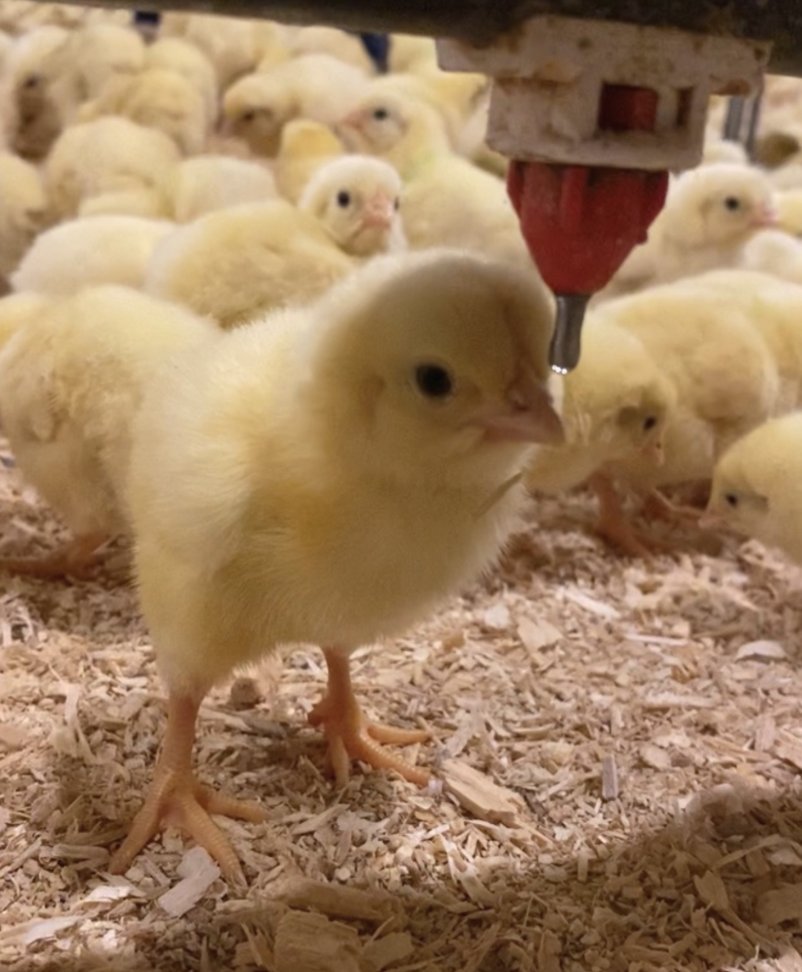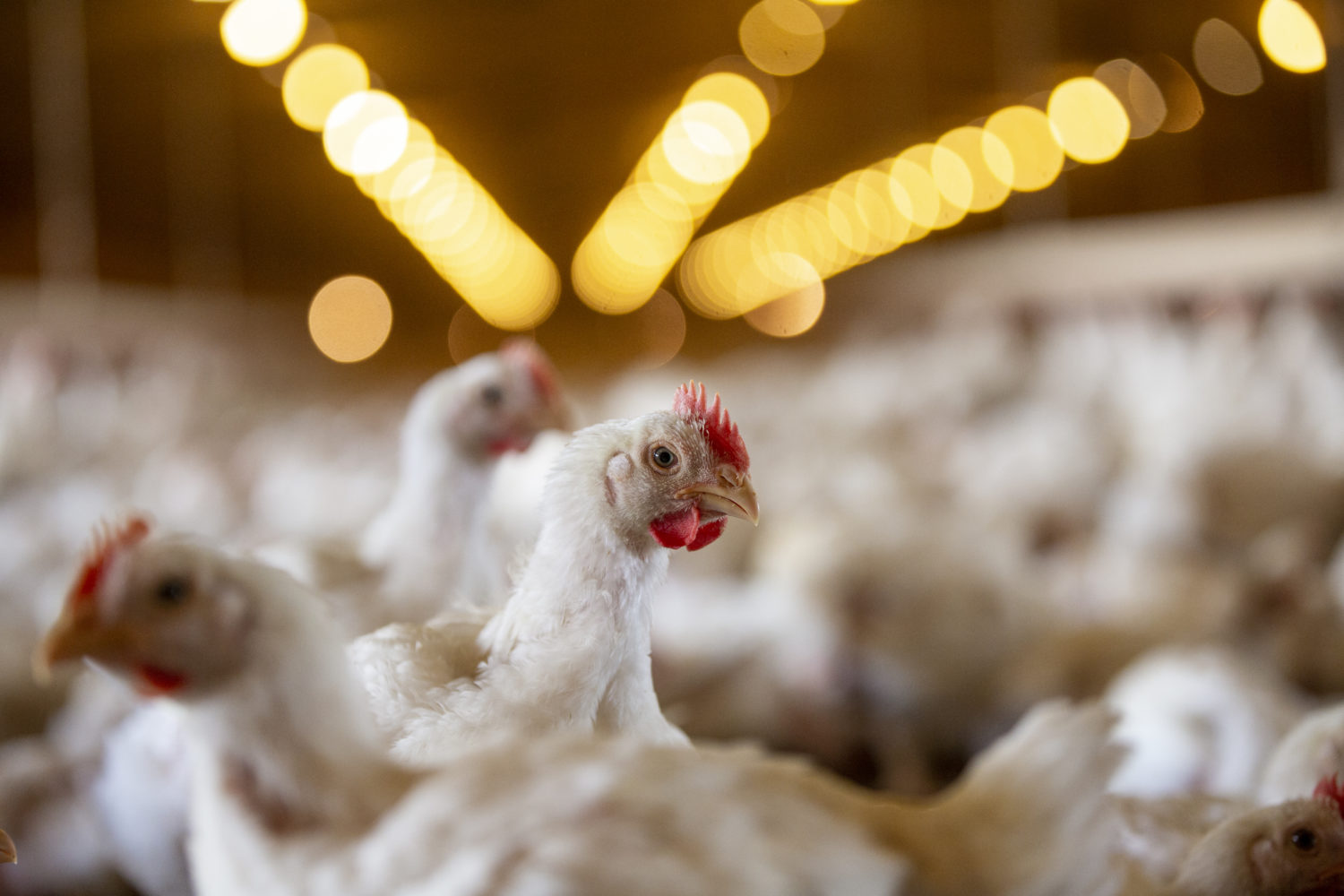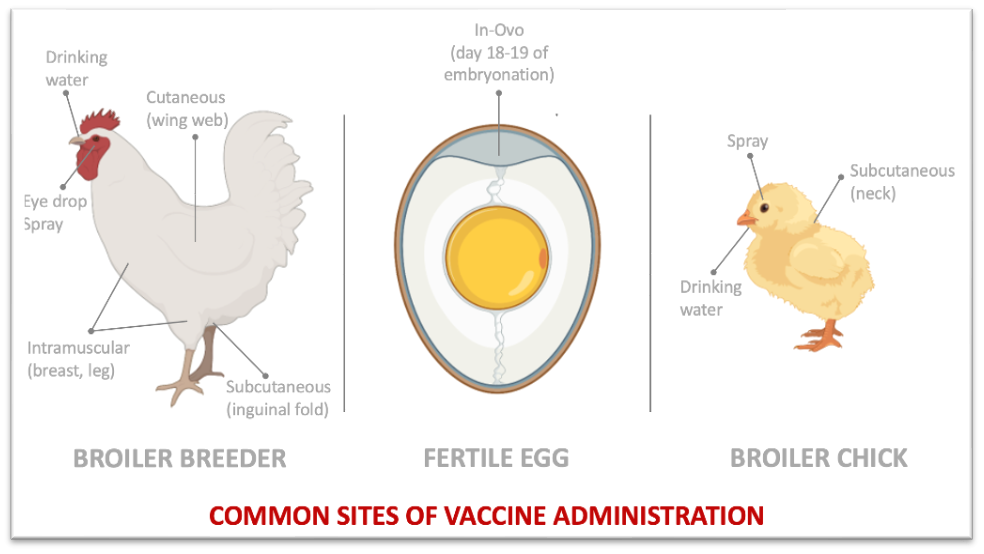Vaccine Use in Broilers Chickens: Why do chickens receive vaccinations?
Vaccines are just one of many tools farmers use to keep their broiler flocks healthy in order to contribute to a safe and wholesome food supply. Commercial broiler farms are under a health program designed by a licensed poultry veterinarian.
Why do broiler chickens (chickens raised for meat) receive vaccinations?

Similar to humans and companion animals, broiler chickens receive vaccines as a preventative measure to keep them healthy against harmful diseases. The goal of vaccines is to expose the chicken to a bacteria or a virus in order to train the immune system to recognize and respond to subsequent exposure without risking development of serious disease.
What diseases are chickens most commonly vaccinated against?
Some of the diseases that chickens are vaccinated for include:
- Marek’s Disease Virus – viral disease that may lead to the development of tumors in nerves, spinal column, brain, internal organs, eyes, and skin.
- Coccidiosis – gastrointestinal illness caused by a protozoan.
- Newcastle Disease Virus – viral disease that causes respiratory, nervous, and digestive illness. This disease can be so severe it causes death without clinical signs.
- Infectious Bronchitis Virus – viral disease that causes upper respiratory tract illness. Some strains attack the reproductive tract and kidneys.
- Infectious Bursal Disease – viral disease that targets the immune system, resulting in immunosuppression and secondary infections.
- Reovirus – viral disease that causes inflammation of the leg joints (arthritis) and/or tendons (tenosynovitis).
- Avian Encephalomyelitis – viral diseases that targets the nervous system in very young chicks and can be passed from the hen to the chick.
- Fowlpox Virus – viral disease that causes nodular lesions that can affect un-feathered skin and the upper gastrointestinal and respiratory tracts.
- Chicken Infectious Anemia Virus – viral disease that targets the immune system in very young chicks, resulting in immunosuppression and secondary infections.
- Fowl Cholera – bacterial disease that can cause swelling, inflammation, and abscesses of face, ear, wattles, foot, or joints. This disease can also cause death without any clinical signs.
- Infectious Laryngotracheitis – viral disease that causes upper respiratory tract illness.
- Salmonella – bacterial disease that poses risk of foodborne illness in humans.
What are the main vaccines administered to broiler chickens in the U.S.?

Vaccination is a two-pronged approach. The poultry industry not only vaccinates broiler chickens from important diseases but also the parent stock (broiler breeders). The purpose of vaccinating the parent stock is to protect the hen herself, to prevent diseases that can be transferred from hen to chick (vertical transmission), and for the hen to pass on maternal antibodies (passive immunity) to their chicks.
Vaccines can be categorized into modified-live, inactivated (killed), and recombinant/viral-vector vaccines. Messenger RNA (mRNA) vaccines are not used in poultry in the U.S.
- Modified-live vaccines use a weakened live virus that provides quicker and broader immunity that is similar to what is produced by natural exposure.
- Inactivated vaccines use a killed version of the pathogen that elicits a weaker immune response and often requires a booster. Autogenous vaccines are an example of an inactivated vaccine. Autogenous vaccines are customized vaccines which uses an isolate identified at a poultry farm to help protect chickens from that specific pathogen. Salmonella isolates are commonly used for autogenous vaccines.
- Recombinant/viral-vector vaccines use a piece of a virus, such as a protein, that is inserted into a different replicating virus to deliver protection and provide a strong immune response to that targeted part of the virus.
How are vaccines administered to broiler chickens?
Effective vaccination relies on proper administration and management. Vaccines can be administered via drinking water, spray, eye-drop, injection, or in-ovo (meaning that the vaccine is injected in the egg).
- Recombinant vaccines can be administered in-ovo which is accomplished by injecting the air cell of fertile eggs (targeting amniotic sac or intramuscular/subcutaneous administration) between 18 or 19 days of incubation using a machine at the hatchery or can be injected at day of age.
- Modified-live vaccines can be applied at the hatchery via in-ovo, spray, or injection or on the farm via drinking water, spray, eye-drop, or injection. Inactivated vaccines are commonly used in broiler breeders since this type of vaccine requires individual administration via injection.
- Vaccines can be injected via cutaneous (wing-web), sub-cutaneous (inguinal fold, neck), or intramuscular (breast, leg) routes.
Poultry veterinarians try to match the where the vaccine is administered to how chickens would be naturally exposed to that specific pathogen. For example, drinking water administration is used for modified-live vaccines, such as infectious bursal disease, since the target organ of this disease is the gut.

See how vaccine mists are administered to broiler chicks:
How do vaccinations impact the health and well-being of chickens?
The application of vaccines in commercial flocks is an integral strategy in preventing and controlling diseases in poultry. Without the use of vaccines, chickens would be susceptible to contagious and severe diseases which could impact bird health, production, and welfare, and ultimately affect the food supply.
Are these vaccines safe?
Commercial poultry vaccines are reviewed and approved by the United States Department of Agriculture Center for Veterinary Biologics (CVB) in the Animal and Plant Health Inspection Service. To manufacture and sell vaccines, animal health companies must have an establishment license granted by the CVB. Additionally, manufacturers must have a product license from CVB which ensures compliance with the four core principles outlined in the Virus-Serum-Toxin Act of 1913: purity, potency, safety, and efficacy.
References
The Poultry Site: Vaccine Administration to Poultry Flocks
WATT Poultry: Pros and cons of common poultry vaccination strategies
MERCK Veterinary Manual: Poultry
MERCK Veterinary Manual: Vaccination Program for Broiler Breeders
MERCK Veterinary Manual: Tables
Animal Health Institute: Approval and Regulation of Animal Medicines
